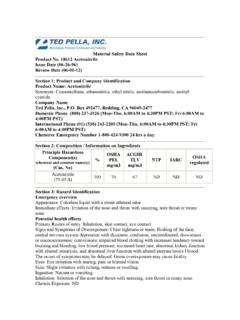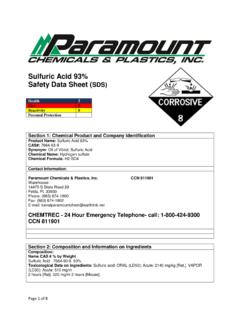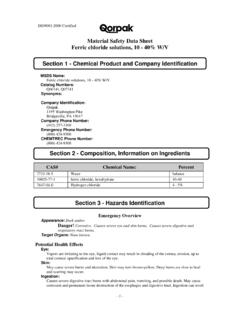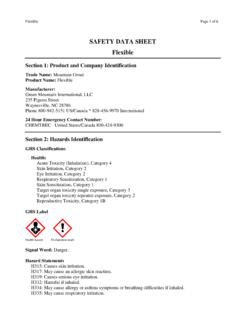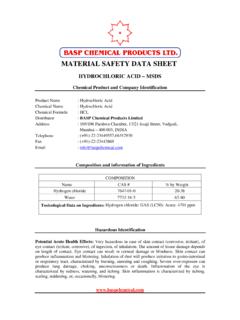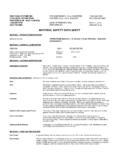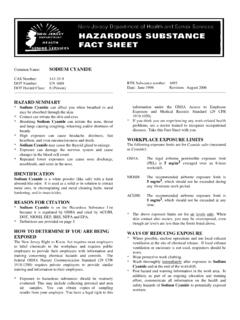Transcription of Sodium Cyanide SAFETY DATA SHEET
1 Page 1 of 10 First Issue : Dec. 1, 2010 Revised : June. 20, 2017(Revised No. : 7) SDS No. : TS-003(EU) Sodium CyanideSAFETY data SHEETA ccording to Regulation (EC) No 1907/2006 (REACH), Annex II(COMMISSION REGULATION (EU) No 2015/830)11. IDENTIFICATION OF THE SUBSTANCE / MIXTURE AND OF THE COMPANY / Product identifierSubstance name : Sodium CyanideEC Number : 205-599-4 CAS Number : 143-33-9 REACH Pre-Registration Number : Relevant identified uses of the substance or mixture and uses advised againstSynthesis of Chemical and Pharmaceutical IntermediatesFormulation of Chemical ProductsCleaning and Degreasing in Metal Finishing IndustriesDepressing AgentExtraction Agent of Precious MetalsRecycling of Precious MetalsElectroplatingMetal Details of the supplier of the SAFETY data SHEET Only Representative:Name : Envigo Research LtdAddress : Shardlow Business Park, London Road, Shardlow, Derbyshire, DE72 2GD United KingdomTelephone number : +44 (0)1332 792896E-mail : Non-Community manufacturer :Company.
2 Tongsuh Petrochemical Corp., ltd. 108-70, Sapyeong-ro, Nam-gu, Ulsan, 44785 Republic of Korea Telephone number : +82-2-3215-0721 Telefax number : +82-2-3215-0770E-mail address : Emergency telephone number +82 52 259 7691 Tongsuh Petrochemical Corp., ltd. (Republic of Korea)+82 52 260 07742. HAZARDS IDENTIFICATION Classification of the substance or mixture Classification according to Regulation (EC) No. 1272/2008 [CLP/GHS] Corrosive to metals, Category 1, H290 Acute toxicity - oral, Category 1, H300 Acute toxicity - dermal, Category 1, H310 Acute toxicity - inhalation, Category 1, H330 Acute aquatic toxicity, Category 1, H400 Page 2 of 10 First Issue : Dec. 1, 2010 Revised : June. 20, 2017(Revised No. : 7) SDS No.
3 : TS-003(EU) Sodium CyanideSAFETY data SHEETA ccording to Regulation (EC) No 1907/2006 (REACH), Annex II(COMMISSION REGULATION (EU) No 2015/830)2 Specific target organ toxicity - repeated exposure, Category 1, Label elements Labelling according to Regulation (EC) No 1272/2008 [CLP] Hazard Pictograms Signal word : Danger Hazard statements:H290 May be corrosive to Fatal if Fatal in contact with Fatal if Causes damage to organs through prolonged or repeated exposure. (See Section 11.)H400 Very toxic to aquatic : Contact with acids liberates very toxic statements: 1) Prevention P234 Keep only in original container. P260 Do not breathe dust/fume/gas/mist/vapours/spray. P262 Do not get in eyes, on skin, or on clothing. P264 Wash hands thoroughly after handling. P270 Do no eat, drink or smoke when using this Use only outdoors or in a well-ventilated area.
4 P273 Avoid release to the Wear protective gloves / protective clothing / eye protection / face Wear respiratory protection. 2) ResponseP301+P310 IF SWALLOWED : immediately call a POISON CENTER or doctor / +P352 IF ON SKIN : wash with plenty of soap and +P340 IF INHALED : remove victim to fresh air and keep at rest in a position comfortable for Immediately call a POISON CENTER or doctor/physician. P314 Get medical advice/attention if you feel unwell. P320 Specific treatment is urgent P321 Specific treatment P322 Specific measures P330 Rinse mouth. P361 Remove/Take off immediately all contaminated clothing. P363 Wash contaminated clothing before reuse. P390 Absorb spillage to prevent material damage. P391 Collect spillage. Page 3 of 10 First Issue : Dec. 1, 2010 Revised : June. 20, 2017(Revised No. : 7) SDS No. : TS-003(EU) Sodium CyanideSAFETY data SHEETA ccording to Regulation (EC) No 1907/2006 (REACH), Annex II(COMMISSION REGULATION (EU) No 2015/830)33) StorageP403+P233 Store in a well-ventilated place.
5 Keep container tightly Store locked up. P406 Store in corrosive resistant container with a resistant inner liner. 4) DisposalP501 Dispose of contents/container in accordance with local/regional/national/international regulation Other hazardsAll known hazards are described by this SAFETY data COMPOSITION / INFORMATION ON SubstanceSubstance name: Sodium CyanideEC Number: 205-599-4 CAS Number: 143-33-9 Purity: >98 wt%Impurities or other constituents contributing to substance classification: Not applicable4. FIRST AID Description of first aid measuresInhalationImmediately remove from amyl nitrile inhalation, 1 ample ( ) every 5 breathing has stopped or is depressed, give medical attention contactImmediately remove the contaminated clothing and shoes from the wash affected area thoroughly with soap or mild detergent and plenty of medical attention contactImmediately and gently flush the affected eye(s) well with plenty of clean water, occasionally lifting upper and lower lids.
6 Seek medical attention vomiting by giving lukewarm water or dilute Sodium chloride the victim is unconscious, never give anything by mouth and seek medical attention Most important symptoms and effects, both acute and delayedFirst aider needs to protect Cyanide irritates severely the eye, the skin and the respiratory of the eyes or skin, Nausea, Headache, Breathing difficulties, Palpitation, Weakness of arms and/ or legs. Sodium Cyanide may cause effects on the cellular respiration, resulting in convulsions and 4 of 10 First Issue : Dec. 1, 2010 Revised : June. 20, 2017(Revised No. : 7) SDS No. : TS-003(EU) Sodium CyanideSAFETY data SHEETA ccording to Regulation (EC) No 1907/2006 (REACH), Annex II(COMMISSION REGULATION (EU) No 2015/830) Indication of any immediate medical attention and special treatment neededCheck that decontamination of patient is complete before patient is conscious, lucid and able to communicate, then significant poisoning may not have oximeter can be used by appropriately trained staff to monitor blood gases until trained medical help personnel should be transferred to the hospital and monitored for continuing of breath, air hunger , gasping respiration or feelings of suffocation are symptoms of FIREFIGHTING Extinguishing mediaSuitable extinguishing mediaSodium Cyanide itself is extinguishing mediaDo not use water Special hazards arising from the substance or mixtureNo data Advice for fire fightersWear self-contained breathing apparatus and protective ACCIDENTAL RELEASE Personal precautions.
7 Protective equipment and emergency proceduresEvacuate personnel to safe unnecessary personnel suitable protective equipment (See Section 8 Exposure Controls / Personal Protection ).Do not enter scene without proper Personal Protective Environmental precautionsAvoid release to the not let the material get into the public sewage not use neutralization agent to try and neutralize Cyanide contaminated rivers, streams of other Methods and material for containment and cleaning upCollect in a suitable or sweep not flush with cleaning, flush away traces with Reference to other sectionsRefer to Section 8 for personal protective equipment, Section 13 for disposal information, and Section 15 for Release Reporting information, if 5 of 10 First Issue : Dec. 1, 2010 Revised : June. 20, 2017(Revised No. : 7) SDS No. : TS-003(EU) Sodium CyanideSAFETY data SHEETA ccording to Regulation (EC) No 1907/2006 (REACH), Annex II(COMMISSION REGULATION (EU) No 2015/830)57.
8 HANDLING AND Precautions for safe handlingAlways have on hand a Cyanide first-aid kit, together with proper suitable protective equipment (See Section 8 Exposure Controls/Personal Protection).Do not not get in eyes, on skin or on only with adequate container contact with skin, wash immediately with plenty of Conditions for safe storage, including any incompatibilitiesStore in a place accessible by authorized persons locked up. Keep container tightly closed in a dry and well-ventilated Specific end uses(s)No data EXPOSURE CONTROLS / PERSONAL Control parametersOccupational exposure limits Country Exposure Limit Legal Basis ACGIH(USA) STEL-C 5 mg/m3 skin 2016 Spain VLA-EC 5 mg/m3 skin 2011 Occupational exposure limits and/or biological limits for air contaminantsNone establishedWorkersDNEL/DMELA cute - systemic Effects Dermal mg/kg bw/dayAcute - systemic Effects Inhalation mg/m3 Long term - systemic Effects Dermal mg/kg bw/dayLong-term - systemic Effects - Inhalation Exposure controlsRecommended Monitoring Procedures.
9 Personal, workplace atmosphere or biological monitoring may be required to determine the effectiveness of the ventilation or other control measures and/or the necessity to use respiratoryprotective engineering controlsHandle only in totally enclosed exhaust ventilation or other engineering controls to keep the relevant airborne concentrationsbelow their respective occupational exposure explosion-proof ventilation that eyewash stations and SAFETY showers are close to the workstation protection measures, such as personal protective equipment (PPE)Personal Protective MeasurersPage 6 of 10 First Issue : Dec. 1, 2010 Revised : June. 20, 2017(Revised No. : 7) SDS No. : TS-003(EU) Sodium CyanideSAFETY data SHEETA ccording to Regulation (EC) No 1907/2006 (REACH), Annex II(COMMISSION REGULATION (EU) No 2015/830)6 Eye/face Protection:Do not get in chemical splash SAFETY full face respirator for eye protection if exposures are likely to exceed the Short Term Exposure Limit or significant liquid splash potential that eyewash stations and SAFETY showers are close to the workstation respirator is not needed under normal and intended conditions of product use as defined under Engineering Protection:Do not get on skin or thoroughly after that eyewash stations and SAFETY showers are close to the workstation.
10 Wear gloves that cannot be penetrated by chemical or correct choice of protective gloves depends upon the chemicals being handled, the conditions ofwork and use, and the condition of the gloves (even the best chemically resistant glove will breakdown after repeated chemical exposures).Most gloves provide only a short time of protection before they must be discarded and specific work environments and material handling practices vary, SAFETY procedures shouldbe developed for each intended should therefore be chosen in consultation with the supplier/manufacturer and with a fullassessment of the working Protection:Use only with adequate special protective clothing and a full face respirator or a positive pressure, self-containedbreathing apparatus(SCBA). Keep container protection:Ensure that eyewash stations and SAFETY showers are close to the workstation Measures:Wash hands after handling this material and before eating, smoking, using lavatory and at the end ofthe that eyewash stations and SAFETY showers are close to the workstation PHYSICAL AND CHEMICAL Information on basic physical and chemical propertiesAppearance(state, color) : Solid(white)Odour : nonepH : 11-12 (20g/l water)Melting/freezing point : 564 CBoiling point : 1496 CFlash point : Not applicableVapour pressure : 133kPa (at 817 C)Relative density : (at 20 C )Solubility : 58g/l at 20 C in waterPartition coefficient;n-octanol/water : Not applicablePage 7 of 10 First Issue : Dec.
